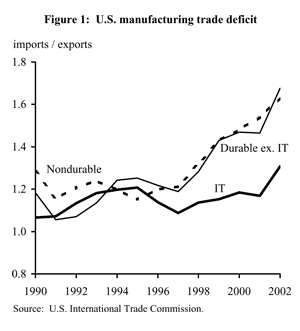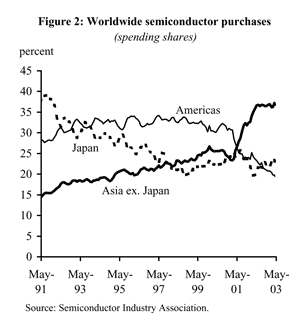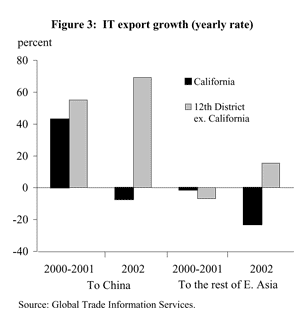The United States arguably is the world’s foremost producer of information technology (IT) products, and for many of these products, the U.S. defines the “leading edge,” or most advanced available technology. Within the U.S., the Twelfth District in particular specializes in IT production. However, amidst the current prolonged slowdown in worldwide IT spending, signs are emerging of a potential erosion of the U.S. competitive advantage.
- IT trade flows show increasing trade deficits with China
- Twelfth District trends
- Understanding the shift
- Reference
The United States arguably is the world’s foremost producer of information technology (IT) products, and for many of these products, the U.S. defines the “leading edge,” or most advanced available technology. Within the U.S., the Twelfth District in particular specializes in IT production. However, amidst the current prolonged slowdown in worldwide IT spending, signs are emerging of a potential erosion of the U.S. competitive advantage. In 2002, the U.S. trade deficit for IT products increased substantially, with China accounting for much of the change. The rising U.S. IT trade deficit indicates a shift in the locus of IT manufacturing activity, which may be holding down growth in the domestic IT manufacturing sector to some degree.
In this Economic Letter, I examine the changing patterns of IT trade to help assess whether the U.S. competitive advantage is indeed eroding. Some U.S. manufacturers of IT products are well-positioned to take advantage of the shift toward low-cost overseas assembly operations in China and other countries. However, the longer-run impact of these shifts, especially given China’s growing skill base and the tax advantages conferred on firms that locate there, may point to the need for a renewed domestic focus on economically sound policies to help the U.S. IT sector realize its full potential in the years ahead.
IT trade flows show increasing trade deficits with China
To put the IT trade balance in context, it is useful to compare the U.S. trade balance in manufactured IT products to that for other manufactured products (Figure 1; trade balance expressed as the ratio of imports to exports).  The definition of IT used here largely corresponds to the broad definition used by the American Electronics Association, which includes computer, electronic, and communications equipment, consumer audio and video equipment, and medical and other instruments. The U.S. trade deficit began to increase substantially in 1997, when the U.S. dollar was in general quite strong (although it depreciated in 2002). Although the trade deficit for IT products has been smaller than for other manufactured products in ratio terms, it increased noticeably in 2002, as exports fell substantially and imports remained essentially flat. In dollar terms, the increased IT trade deficit in 2002 is large, about one-third of the estimated decline in the value of U.S. IT output in 2002.
The definition of IT used here largely corresponds to the broad definition used by the American Electronics Association, which includes computer, electronic, and communications equipment, consumer audio and video equipment, and medical and other instruments. The U.S. trade deficit began to increase substantially in 1997, when the U.S. dollar was in general quite strong (although it depreciated in 2002). Although the trade deficit for IT products has been smaller than for other manufactured products in ratio terms, it increased noticeably in 2002, as exports fell substantially and imports remained essentially flat. In dollar terms, the increased IT trade deficit in 2002 is large, about one-third of the estimated decline in the value of U.S. IT output in 2002.
During most of the 1990s, the U.S. IT deficit was most pronounced with Japan. But as of 2002, the U.S. IT trade deficit with the rest of East Asia outstripped the U.S. IT trade deficit with Japan (in ratio and dollar terms). Within East Asia, the net increase can be accounted for entirely by trade with mainland China, as the U.S. IT trade deficit with other major East Asian trading partners has been relatively constant (Hong Kong is included separately from China). Of the $17 billion increase in the U.S. IT trade gap in 2002, close to half ($7.2 billion) was due to the change in trade flows with China alone, as U.S. imports from China rose sharply while exports to China rose only a bit. Most of the remaining increase in the IT trade gap in 2002 ($6.4 billion) was due to a change in trade flows with the European Union (a sharp drop in exports accompanied by nearly flat imports). The growing importance of East Asia in the IT manufacturing supply chain is consistent with the regional pattern in worldwide semiconductor sales revenues, based on region of use. In recent years, growth has been noticeably more rapid in Asia (excluding Japan) than in the rest of the world. This has caused a sharp increase in Asia’s share of worldwide sales since early 2001, which was largely matched by a sharp decline in the share of sales to the “Americas” (mostly the U.S.)  (Figure 2). China probably accounts for a large portion of that growth, due to its expanding role as a center for low-cost manufacturing and assembly of standardized IT products; according to the Chinese Semiconductor Industry Association, the overwhelming majority of semiconductors used in these products are imported into China. As examples, China accounts for a significant and growing share of worldwide output of notebook computers, flat-panel displays, game boxes, DVD players, mobile phones, and handheld computing devices. Some Chinese companies that design and manufacture their own products, such as the computer maker Legend, have made substantial inroads in the rapidly growing domestic Chinese market. However, such companies have had little or no success at selling their products in overseas export markets.
(Figure 2). China probably accounts for a large portion of that growth, due to its expanding role as a center for low-cost manufacturing and assembly of standardized IT products; according to the Chinese Semiconductor Industry Association, the overwhelming majority of semiconductors used in these products are imported into China. As examples, China accounts for a significant and growing share of worldwide output of notebook computers, flat-panel displays, game boxes, DVD players, mobile phones, and handheld computing devices. Some Chinese companies that design and manufacture their own products, such as the computer maker Legend, have made substantial inroads in the rapidly growing domestic Chinese market. However, such companies have had little or no success at selling their products in overseas export markets.
A substantial amount of Chinese IT production takes place at foreign-owned establishments or through foreign outsourcing of manufacturing and assembly activities to Chinese companies. A key incentive for foreign manufacturers is low production costs relative to alternative locations; Chinese labor costs are quite low compared to labor costs in advanced industrial nations or developing countries that compete with China (although China’s cost advantage shrinks substantially when productivity differences and non-labor costs are taken into account). Moreover, in 2000, China implemented a series of tax policies that give preferential treatment to foreign IT manufacturers who locate in China. These policies include reductions in the national value added tax for foreign semiconductor makers who establish manufacturing sites in China and reductions in national and local income taxes for foreign enterprises that specialize in IT products (see Chao and Sussman 2003 for details). In addition, China has the advantage of a large and growing number of skilled engineers, many of whom received training and sometimes IT work experience in the U.S. and other advanced countries.
Some U.S. firms are well-positioned to exploit China’s growing role in IT production and trade. Although the lack of import data precludes calculation of IT trade balances for Twelfth District states, export data are available. California IT exports to China grew rapidly in 2000 and 2001 (Figure 3).  Although these exports fell a bit in 2002, they remained at a level nearly double that in 1999, which suggests that IT producers in California have been able to exploit the rapid growth of IT production in China by substantially increasing their exports of intermediate IT products to China.
Although these exports fell a bit in 2002, they remained at a level nearly double that in 1999, which suggests that IT producers in California have been able to exploit the rapid growth of IT production in China by substantially increasing their exports of intermediate IT products to China.
This trend was even more pronounced in the District outside California, which saw a surge in IT exports to China in 2000-2002. Most of this increase was attributable to Oregon in 2001 and to Oregon plus Arizona in 2002. This surge largely reflects increased exports of Intel microprocessors for use by Chinese computer makers; Intel has manufacturing facilities in both states, and the export increase was especially pronounced for the detailed product category that includes microprocessors. Although IT exports to China were over twice as large for California as for the rest of the District in 2002, the increase for these other states in 2002 was larger than the decline for California. Moreover, for the District as a whole, IT exports to East Asia outside of China fell during 2000-2002, which suggests that to some degree China is supplanting other East Asian countries in the worldwide IT supply chain.
Of course, some Twelfth District IT firms may be harmed by increased direct competition from overseas manufacturers. However, Twelfth District IT companies in general are well-positioned to take advantage of the growth in low-cost production in China. The District’s geographic proximity to Asia reduces the cost of the necessary business contacts throughout the region. Moreover, the District’s extensive Asian population and culture provides a commonality that supports sustained business partnerships.
One key question arising from these trade patterns is: What caused such an abrupt shift in the U.S. IT trade deficit with China in 2002? A partial explanation lies in the nature of the slowdown in worldwide IT sales that began in late 2000. The slowdown has been especially pronounced for business spending on IT capital goods, which also is the focus for U.S. IT exports. By contrast, China specializes more in exports of IT consumer goods. Growth in U.S. consumer spending in 2002 therefore led to solid increases in U.S. IT imports from China, while U.S. IT exports to China grew more modestly.
In addition, as discussed above, in 2000 China instituted policies aimed at supporting development of the IT industry. Around the same time, China also achieved more complete acceptance in the world trade community. In particular, China was granted Permanent Normal Trade Relations (PNTR) with the U.S. in October 2000 and membership in the World Trade Organization (WTO) in December 2001. Because it takes time to establish new production facilities and to invest in new business relationships—such as contracts for outsourced production—China’s IT trade surge in 2002 likely reflects in part a lagged response to IT development polices and the country’s newly acquired trade status.
Despite the significant trade inroads China’s IT industry made in 2002, the immediate threat to U.S. ascendancy in worldwide IT development and production remains somewhat limited. China’s recent gains largely reflect normal product-cycle dynamics, in which the diffusion of technology enables less advanced countries to manufacture products that initially were manufactured only in advanced countries. At this time, China’s IT sector focuses primarily on assembly of less-advanced products at low cost, which does not threaten the U.S. dominance in leading-edge technology and innovative products. Moreover, China’s growing role as a low-cost producer generates substantial benefits for U.S. users of IT products through resulting price reductions on IT equipment.
In the longer run, however, the U.S. may face a significant trade-induced reduction in domestic IT manufacturing activity and an erosion of the knowledge and skill base associated with it. This may undercut the competitive advantage enjoyed by U.S. IT manufacturers, which is based on the ability to identify and develop innovative products that spur worldwide growth in the IT industry.
A variety of policy responses to this long-term challenge are possible. One area of active concern is the protection of intellectual property of foreign firms locating in China; the Chinese have strengthened domestic law in this regard in recent years, but enforcement reportedly remains an issue. In conjunction with China’s targeted tax policies, the resulting transfer of technology and innovation will support the expansion of China’s IT manufacturing sector, possibly at the expense of IT manufacturers in the U.S. Thus, China’s strategic IT policies place a burden on the U.S. to identify and implement economically sound strategies to maintain the base of skills, knowledge, and physical capital underlying IT innovation, thereby allowing the U.S. IT sector to realize its full potential going forward. Such policies may include, but are not limited to, public support for advanced education and training programs and federal and state tax policies that recognize the unique financial features of IT manufacturing, especially in regard to rapid capital depreciation and the substantial upfront costs of research and development activities.
Rob Valletta
Research Advisor
Chao, Howard, and Lawrence Sussman. 2003. “Semiconductor Investment Heats up in China: A Legal and Tax Guide.” Report, O’Melveny & Myers LLP, June.
Opinions expressed in FRBSF Economic Letter do not necessarily reflect the views of the management of the Federal Reserve Bank of San Francisco or of the Board of Governors of the Federal Reserve System. This publication is edited by Anita Todd and Karen Barnes. Permission to reprint portions of articles or whole articles must be obtained in writing. Please send editorial comments and requests for reprint permission to research.library@sf.frb.org